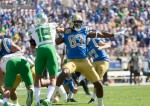Alex Van Dyke wanted an opportunity to get more time on the field.
So when the opportunity arose, he took it.
“I realized that our tight ends were going down and I wanted to help out the team,” Van Dyke said. “It’s an opportunity to get on the field. So I went up to (offensive coordinator Jedd Fisch), I was like, ‘You can use me.'”
The senior recently made the transition from wide receiver to tight end for UCLA football (4-3, 2-2 Pac-12) after a conversation with Fisch following one of last week’s practices. Injuries to multiple tight ends, including redshirt sophomore Caleb Wilson, had left the position lacking depth.
Despite missing two games, Wilson still ranks third on the team with 490 receiving yards and averaged a team-high 98.0 yards per game before his injury.
“We all know that we have to step up because Caleb was a big part of our room and he kind of set an example of how we’re all supposed to play,” said redshirt freshman Jordan Wilson. “Now that he’s out, we just gotta all step up in all areas of our game, so that’s what we’ve been trying to do.”
On top of Caleb Wilson being sidelined, an injury to redshirt junior tight end Austin Roberts during the Oregon game opened up a space for Van Dyke.
“We had a situation where unfortunately we were down some men in this game,” Fisch said after Saturday’s game. “Austin gets hurt the second play, and now Alex, who we moved from wide receiver to tight end a week ago and now jumps into the game. It’s not like he had training camp, it’s not like he had spring ball.”
Van Dyke has played in all seven games this season, but has only five catches for 33 yards on his career.
The former wide receiver said the main difference between the positions is the stance and the size of the players on the other side of the line of scrimmage, but the rest – routes, blocking, catching and running – are the same as being a receiver.
“We’ve been talking to him just about, mainly just footwork with blocking, because he was already a great blocker at the wide receiver position,” Jordan Wilson said. “He’s got good leverage, good hands, it’s just a footwork thing with him and he’s going to get a lot better as the season goes on.”
At only 215 pounds, Van Dyke is undersized for a tight end, which adds extra challenge to the switch from wide receiver.
“The guys are just bigger. It’s getting the right leverage and just getting the right blocks,” Van Dyke said. “For my size, it’s more about technique and leverage.”
Van Dyke said tight end coach Rip Scherer has been helpful with teaching him these technical aspects of the position, such as the correct footwork.
Although Van Dyke got a late start at the position, Fisch said he loves that Van Dyke asked for the move, and they will work to get him to be better.
“Fisch, he liked that I took initiative,” Van Dyke said. “He was excited for it, just like I was.”
